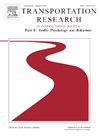Research on drivers’ hazard perception and visual characteristics before vehicle-to-powered two-wheeler collisions
IF 3.5
2区 工程技术
Q1 PSYCHOLOGY, APPLIED
Transportation Research Part F-Traffic Psychology and Behaviour
Pub Date : 2025-06-20
DOI:10.1016/j.trf.2025.06.014
引用次数: 0
Abstract
Understanding drivers’ hazard perception levels and visual behavior in conflict scenarios is crucial for improving traffic safety and advancing intelligent driving systems, especially given the growing complexity of traffic conditions and the rapid evolution of intelligent driving technologies. This study examines typical near-collision scenarios involving vehicles and powered two-wheelers, focusing on the effects of collision scenarios, driving states, and risk conditions on drivers’ hazard perception and visual characteristics. Using quantile regression and generalized linear mixed models, the study quantitatively assesses how these factors influence hazard perception and visual behavior, uncovering the visual response mechanisms underlying hazard perception. The results reveal that different vehicle-to-powered two-wheeler collision scenarios significantly affect drivers’ hazard perception and visual behavior. Drivers exhibited higher hazard perception levels and collision avoidance success rates in “Crossing from Right” and “Cut-in from Right” scenarios, whereas lower hazard perception abilities were observed in “Crossing from Left” and “Oncoming” scenarios. Fatigue was shown to severely impair drivers’ alertness and visual search abilities, resulting in diminished hazard perception levels. Under high-risk conditions, while drivers exhibited reduced collision avoidance success rates, their heightened attention and vigilance toward powered two-wheeler enhanced hazard perception. Besides, the study also highlights a strong correlation between visual characteristics and drivers’ hazard perception. These findings are significant for understanding the mechanisms underlying drivers’ hazard perception in intersection scenarios and may provide a scientific basis for future developments in human–machine collaborative monitoring and intelligent traffic safety strategies.
两轮车碰撞前驾驶员危险感知与视觉特征研究
了解驾驶员在冲突场景中的危险感知水平和视觉行为对于提高交通安全和推进智能驾驶系统至关重要,特别是考虑到日益复杂的交通状况和智能驾驶技术的快速发展。本研究考察了典型的近碰撞场景,包括车辆和动力两轮车,重点研究碰撞场景、驾驶状态和风险条件对驾驶员危险感知和视觉特征的影响。采用分位数回归和广义线性混合模型,定量评价了这些因素对危害感知和视觉行为的影响,揭示了危害感知背后的视觉反应机制。结果表明,两轮车碰撞场景对驾驶员的危险感知和视觉行为有显著影响。驾驶员在“从右侧穿过”和“从右侧切入”情景下的危险感知水平和避碰成功率较高,而在“从左侧穿过”和“迎面而来”情景下的危险感知能力较低。研究显示,疲劳会严重损害司机的警觉性和视觉搜索能力,导致对危险的感知水平下降。在高风险条件下,尽管驾驶员表现出较低的避碰成功率,但他们对电动两轮车的高度关注和警惕增强了对危险的感知。此外,该研究还强调了视觉特征与驾驶员危险感知之间的强相关性。这些研究结果对于理解交叉口驾驶员危险感知机制具有重要意义,并可为未来人机协同监测和智能交通安全策略的发展提供科学依据。
本文章由计算机程序翻译,如有差异,请以英文原文为准。
求助全文
约1分钟内获得全文
求助全文
来源期刊
CiteScore
7.60
自引率
14.60%
发文量
239
审稿时长
71 days
期刊介绍:
Transportation Research Part F: Traffic Psychology and Behaviour focuses on the behavioural and psychological aspects of traffic and transport. The aim of the journal is to enhance theory development, improve the quality of empirical studies and to stimulate the application of research findings in practice. TRF provides a focus and a means of communication for the considerable amount of research activities that are now being carried out in this field. The journal provides a forum for transportation researchers, psychologists, ergonomists, engineers and policy-makers with an interest in traffic and transport psychology.

 求助内容:
求助内容: 应助结果提醒方式:
应助结果提醒方式:


